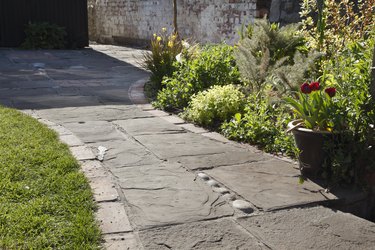
Limestone is a natural stone harvested from quarries and prized for its longevity. The stone is typically white, gray, or tan in color, but streaks of red, green, blue, and purple are common. Limestone is durable, tolerates freeze and thaw cycles well, and requires almost no maintenance. An occasional cleaning, however, can really keep your outdoor limestone fixtures looking great.
Some Helpful Tips
Video of the Day
Limestone is tough and durable, but it's also porous. When used outdoors, limestone paths, patios, and fixtures are typically sealed to give the stone's natural water repellence a boost. If you notice your limestone absorbing water, it's time to seal it again. Doing so also prevents stains from penetrating the stone.
Video of the Day
When cleaning limestone, always avoid bleach and acidic or harsh chemicals, as these can damage the stone. Soap-based cleansers are also a no-no. Note that limestone pavers used on patios and walkways typically have a rough surface to help prevent slips and falls. You may need to clean the stone with a soft brush to get into all the cracks and crevices.
Things You'll Need
How to Clean Outdoor Limestone
Step 1: Give It a Quick Rinse
The very first step in cleaning your limestone is to sweep away any debris. You can and should also give the area a sweep between deeper cleanings. If left to sit on the limestone, decaying leaves and other natural debris can stain the stone.
- Sweep away any loose dirt and debris from the stone with a soft-bristle broom. You can use a leaf blower instead of a broom if the debris is dry.
- Rinse the limestone with your garden hose. If desired, you can also rinse the stone with a power washer. Do not exceed 1,600 psi, however.
- Inspect the limestone. Sometimes, a thorough rinse is all you need. If the stone still looks dirty or stained, continue cleaning.
Step 2: Wash the Stone
When washing the limestone, use a cleaner specifically intended for that purpose. Other cleaners may prove too abrasive or harsh and can damage the stone. It is tempting to just use a cleanser you already have on hand rather than making a run to the hardware store, but resist the urge.
- Mix the stone cleaner with water as directed on the label.
- Apply the cleaning solution to the stone using a sponge. You can also use your soft-bristle broom if you're cleaning a large area.
- Work in sections, cleaning and then promptly rinsing the stone. Take a towel and dry each section of stone as you finish it. If you let the stone air-dry, any residual stone cleaner may streak or cause smudges.
Step 3: Treat Stains as Necessary
Ideally, the limestone cleaner will lift any stains from your stone. On occasion, however, you may run into a stubborn stain that just won't budge. If so, you'll need to hit it with a spot treatment.
Make a poultice by mixing together baking soda and water to form a paste.
Wet the stain with water and then spread the poultice on top of it. Make the poultice about 1/4 inch thick and make sure you cover the entire stain.
Place plastic food wrap over the poultice and tape down the edges.
Leave the poultice to sit for 48 hours.
Remove the poultice when the 48 hours are up. Brush it away from the limestone and rinse the area thoroughly.
Let the limestone dry completely. If the stain is faded but not quite gone, repeat the poultice treatment a second time.
Tip
If the stain is oil-based, try to remove it with a little acetone-based nail polish remover before applying the poultice. This will help break down the oil and let the poultice do its work more easily.